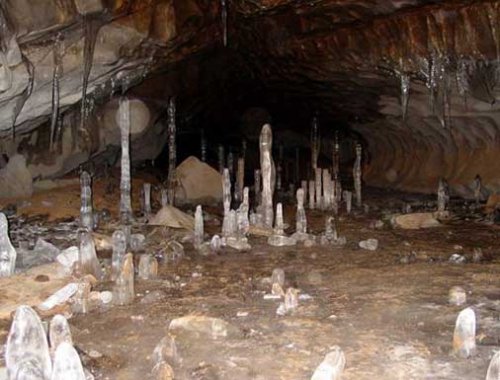Oolite is a cave pearl
In many caves developed in carbonate rocks, (read more: Underground leaching), small calcite balls called oolite - cave pearls - are found.
Pearls are oval, elliptical, spherical, polyhedral, or irregularly shaped. They usually vary in length from 5 to 14 mm and width from 5 to 11 mm.
The largest oolite in the Soviet Union was found in the Maanikvar mine, part of the Anakopi cave system. Its length was 59 mm. In shape and size it resembled a hen's egg.
Flattened pearls predominate. Sometimes they are cemented in several pieces (10-20) and form an oolite conglomerate.
The color of oolites is white or yellowish. Their surface is matte, smooth or rough. 
In the central part of the pearl there are grains of quartz, calcite or lumps of clay around which the shells of colloidal calcium carbonate grow. Interestingly, the crystalline shells of oolites are separated from each other by thin interlayers of pelitomorphic limestone.
Cave pearls are formed in shallow uplift lakes, which are fed by water droplets saturated with calcium carbonate dripping from the ceiling. An important condition for the formation of oolites is their continuous rotation.
As the aggregates grow, their rotation slows down and then stops altogether, as they completely fill the tub in which they are formed. 
Growth of oolites
The growth of oolites depends on many factors. Under favorable conditions, they are formed very quickly (in Postoinska Cave in Yugoslavia in about 50 years). In Hralupa Cave (Bulgaria), oolites with a cross-section of 5 - 6 mm were found, which consisted of only 3 - 4 concentric layers.
Consequently, their age can be determined as 3 - 4 years. However, the possibility of using calcite layering to determine the age of chemogenic formations should be treated with great caution, because "...the periodicity of calcium carbonate deposition does not coincide with the seasons, but is determined only by changes in the amount of incoming water, its temperature and the surrounding air" (N.T. Cholakov. Cave pearls of Bulgaria).
Cave pearls found in the Soviet Union in the caves of Divya, Kizelov, Krasnaya, Anakopi, Shakuran, Vakhushti, Makrushinskaya and some other caves do not differ from biogenic pearls of marine mollusks in their chemical composition, as both are composed of calcium carbonate.
Meanwhile, real pearls differ from cave pearls by a pronounced nacreous luster, which is characteristic of aragonite, with which biogenic pearls are represented.
Aragonite, however, is an unstable modification of calcium carbonate and spontaneously transforms into calcite. However, at ordinary temperature this transformation is rather slow.


